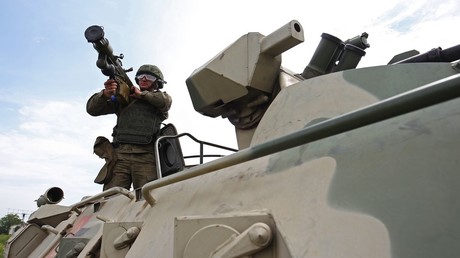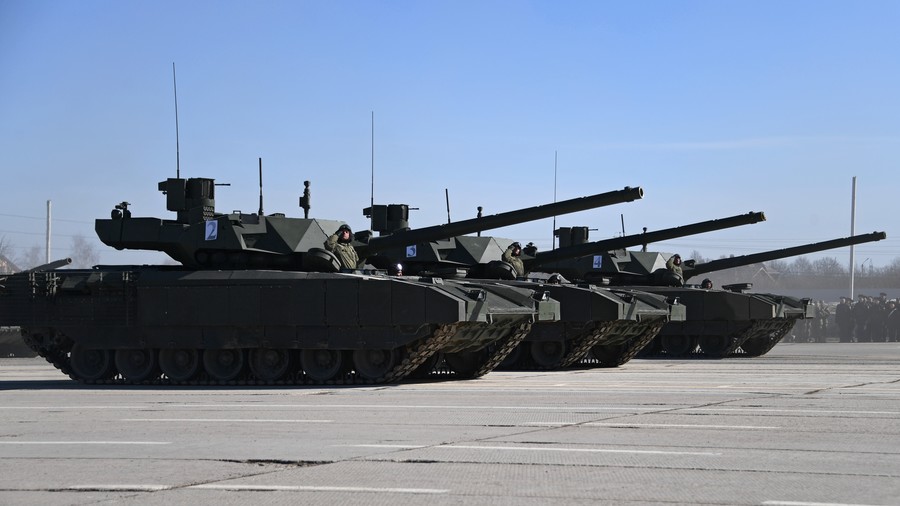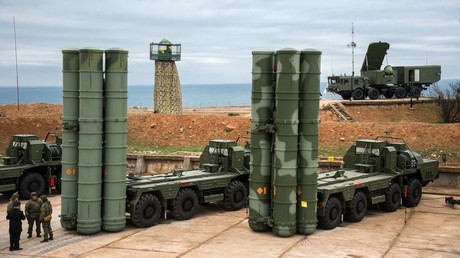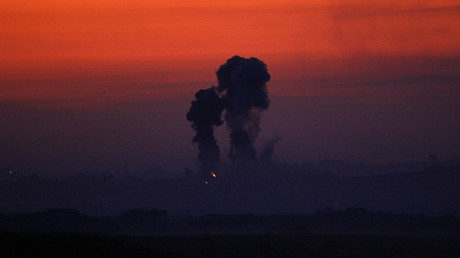- Joined
- Aug 8, 2008
- Messages
- 6,070
- Points
- 83
https://www.rt.com/news/431760-russia-six-advanced-weapons/
HomeWorld News
Russian Army to get 6 unrivaled weapons in coming years – Moscow
Published time: 5 Jul, 2018 07:07
Get short URL

FILE PHOTO: Russia’s new heavy intercontinental ballistic missile (ICBM) Sarmat. © Russian Defense Ministry / Sputnik
The Russian Armed Forces are expected to get new state-of-the-art weapons systems, which have no equals anywhere in the world, a Russian government’s top official said. The new equipment is set to enter service within a decade.
The Russian military is undergoing a large-scale rearmament, which will allow it to make use of some of the world’s most advanced weapon systems, Yury Borisov, the Russian deputy prime minister, who oversees Russia’s military-industrial complex and military-technical policy, said during his speech at the Military Academy of the General Staff.
Read more
 Budget amendments give Russia additional $1.57 billion for new weapons development
Budget amendments give Russia additional $1.57 billion for new weapons development
Some of the new weapons, which are set to enter service in Russia between 2018 and 2027, surpass the existing and even future weapons systems used by other nations, including the NATO member states, Borisov said as he listed what he called six Russian cutting-edge weapons.
Sarmat ICBM
Russia’s new heavy intercontinental ballistic missile (ICBM) Sarmat is one of the most advanced and arguably most extensively discussed weapons. The missile is part of the new arsenal unveiled by the Russian President Vladimir Putin during his state-of-the-nation address on March 1.
An ICBM touted to have an extended range limit, the Sarmat is projected to be able to carry massive payloads across the North or the South pole to anywhere on the planet. Some Western media outlets have already called it a “doomsday weapon,” warning that it could easily penetrate US missile defenses.
The missile is already undergoing tests. The Russian Defense Ministry said it had had its performance confirmed during pre-flight and early-flight stages. In May, Putin revealed that the Sarmat is expected to be deployed in 2020.
The Sarmat is designed to carry a hypersonic glider warhead, codenamed ‘Avangard’ (Advance Guard), which already provoked panic from US intelligence agencies. The glider can fly in the atmosphere at speeds of over Mach 20 and can withstand a heat of up to 2,000C (3,632F) generated by air friction.
5th-generation stealth fighter
Nuclear intercontinental ballistic missiles are far from being the only addition to Russia’s arsenal, as the Russian Army is expected to get some more conventional weapons, which are no less impressive. One of them is a fifth-generation Su-57 stealth fighter. In late June, the Russian military signed the first contract to receive 12 such aircraft. The state-of-the-art jets are set to be delivered to the armed forces next year.
The Su-57, whose avionics system allows autonomous battlefield calculations to assist the pilot, is eventually expected to replace the iconic, but aging, Su-27 multipurpose fighters. The plane boasts low-visibility technologies, widespread usage of composite materials and improved radar. The main armament of the Su-57 is concealed in internal weapon bays in order to reduce the machine’s radar profile, but it can also carry additional munitions on external underwing pylons.
The planes are also expected to be equipped with new engines designed specifically for the fifth generation jets. According to the Military Watch Magazine, the Russian jets have a considerable advantage over the F-35 when it comes to its speed, altitude, sensors, missile carriage, engagement range, and maneuverability.
T-14 Armata tank
On the ground, the Russian Army will soon also have something that can score a hit. Russia’s troops are expected to get as many as 100 Armata-based T-14 main battle tanks by 2020. The war machines will have a fully automated and unmanned turret equipped with a 125mm cannon capable of hitting its targets at a range of seven kilometers. Its cannon has a combat fire rate of 12 rounds per minute.

T-14 Armata tanks. © Grigory Sysoev / Sputnik
The tank's crew is securely placed in a special multi-layer armored crew cell, which is expected to keep the servicemen alive in most critical cases, including ammunition load detonation under certain circumstances. The outside view will be provided by HD cameras. In the future, the tank may be equipped with a drone.
S-500
The backbone of Russia’s long-range air defense architecture, the S-400 Triumf air defense system, might also be replaced by an even better weapon in not so distant future.
Read more
 Russia completes testing extended-range interceptor missile for S-400 system – reports
Russia completes testing extended-range interceptor missile for S-400 system – reports
The S-400 Triumf is one of the most advanced Russian anti-aircraft systems, designed to engage aerodynamic targets at a range of up to 400km and ballistic missiles up to 60km away. The launcher can use at least four interceptor missile types, suited to different targets. One S-400 division can engage up to 36 targets simultaneously.
It has been already eagerly sought by some other nations, as it is available for export. The proliferation of S-400s across the globe has made Washington extremely worried about the growing anti-access and area-denial (A2/AD) capabilities of sovereign nations and even NATO allies. Some lawmakers even argued that integration of Russian technology by US allies might compromise US “technology secrets.” Such concerns came as India, as well as the US' NATO ally Turkey, decided to purchase the systems.
However, now, Almaz-Antey, the producer of the S-400 system, is developing an even more advanced system, codenamed S-500 ‘Prometheus.’
According to some reports, the new system will be capable of hitting targets at a range of up to 480 kilometers and could successfully intercept hypersonic missiles, as well as shoot down F-22 raptor and F-35 jets. S-500 is currently at an advanced development stage and could be deployed around 2020.
‘Nudol’ missile defense shield
Faced with an ever-expanding US global missile defense system, Russia also decided to upgrade its missile defense shield, particularly those used to protect its capital, Moscow. The new ABM interceptor missile system was named Nudol. However, little is known about its exact characteristics so far.
According to TASS, the new missile defense shield would be capable of defending Russian territories from a multiple-warhead nuclear strike and intercept all existing modern ICBMs equipped with systems that are specifically designed to penetrate the missile defense. According to some reports, the new interceptor missiles are even capable of shooting down satellites.
Tirada-2s satellite jammer
Last but not least is Russia’s cutting-edge electronic warfare device codenamed Tirada-2s. While it may not sound impressive in comparison to “doomsday” missiles or fifth-generation stealth fighters, this new equipment might yet prove to be crucial in any modern conflict, as it can actually jam… satellites.
Such technologies, which effectively render the satellites useless, make it difficult for any potential enemy to bypass the jamming and de facto leaves them without any modern communication tools. Eventually, it can significantly shift the balance in modern combat activities, which are increasingly characterized by rapid changes of environment and high requirements for troops’ adaptability, in which communication plays a vital role.
Like this story? Share it with a friend!
Trends:Russia news Russian ICBM
HomeWorld News
Russian Army to get 6 unrivaled weapons in coming years – Moscow
Published time: 5 Jul, 2018 07:07
Get short URL

FILE PHOTO: Russia’s new heavy intercontinental ballistic missile (ICBM) Sarmat. © Russian Defense Ministry / Sputnik
- 46
The Russian Armed Forces are expected to get new state-of-the-art weapons systems, which have no equals anywhere in the world, a Russian government’s top official said. The new equipment is set to enter service within a decade.
The Russian military is undergoing a large-scale rearmament, which will allow it to make use of some of the world’s most advanced weapon systems, Yury Borisov, the Russian deputy prime minister, who oversees Russia’s military-industrial complex and military-technical policy, said during his speech at the Military Academy of the General Staff.
Read more
 Budget amendments give Russia additional $1.57 billion for new weapons development
Budget amendments give Russia additional $1.57 billion for new weapons development Some of the new weapons, which are set to enter service in Russia between 2018 and 2027, surpass the existing and even future weapons systems used by other nations, including the NATO member states, Borisov said as he listed what he called six Russian cutting-edge weapons.
Sarmat ICBM
Russia’s new heavy intercontinental ballistic missile (ICBM) Sarmat is one of the most advanced and arguably most extensively discussed weapons. The missile is part of the new arsenal unveiled by the Russian President Vladimir Putin during his state-of-the-nation address on March 1.
An ICBM touted to have an extended range limit, the Sarmat is projected to be able to carry massive payloads across the North or the South pole to anywhere on the planet. Some Western media outlets have already called it a “doomsday weapon,” warning that it could easily penetrate US missile defenses.
The missile is already undergoing tests. The Russian Defense Ministry said it had had its performance confirmed during pre-flight and early-flight stages. In May, Putin revealed that the Sarmat is expected to be deployed in 2020.
The Sarmat is designed to carry a hypersonic glider warhead, codenamed ‘Avangard’ (Advance Guard), which already provoked panic from US intelligence agencies. The glider can fly in the atmosphere at speeds of over Mach 20 and can withstand a heat of up to 2,000C (3,632F) generated by air friction.
5th-generation stealth fighter
Nuclear intercontinental ballistic missiles are far from being the only addition to Russia’s arsenal, as the Russian Army is expected to get some more conventional weapons, which are no less impressive. One of them is a fifth-generation Su-57 stealth fighter. In late June, the Russian military signed the first contract to receive 12 such aircraft. The state-of-the-art jets are set to be delivered to the armed forces next year.
The Su-57, whose avionics system allows autonomous battlefield calculations to assist the pilot, is eventually expected to replace the iconic, but aging, Su-27 multipurpose fighters. The plane boasts low-visibility technologies, widespread usage of composite materials and improved radar. The main armament of the Su-57 is concealed in internal weapon bays in order to reduce the machine’s radar profile, but it can also carry additional munitions on external underwing pylons.
The planes are also expected to be equipped with new engines designed specifically for the fifth generation jets. According to the Military Watch Magazine, the Russian jets have a considerable advantage over the F-35 when it comes to its speed, altitude, sensors, missile carriage, engagement range, and maneuverability.
T-14 Armata tank
On the ground, the Russian Army will soon also have something that can score a hit. Russia’s troops are expected to get as many as 100 Armata-based T-14 main battle tanks by 2020. The war machines will have a fully automated and unmanned turret equipped with a 125mm cannon capable of hitting its targets at a range of seven kilometers. Its cannon has a combat fire rate of 12 rounds per minute.

T-14 Armata tanks. © Grigory Sysoev / Sputnik
The tank's crew is securely placed in a special multi-layer armored crew cell, which is expected to keep the servicemen alive in most critical cases, including ammunition load detonation under certain circumstances. The outside view will be provided by HD cameras. In the future, the tank may be equipped with a drone.
S-500
The backbone of Russia’s long-range air defense architecture, the S-400 Triumf air defense system, might also be replaced by an even better weapon in not so distant future.
Read more
 Russia completes testing extended-range interceptor missile for S-400 system – reports
Russia completes testing extended-range interceptor missile for S-400 system – reports The S-400 Triumf is one of the most advanced Russian anti-aircraft systems, designed to engage aerodynamic targets at a range of up to 400km and ballistic missiles up to 60km away. The launcher can use at least four interceptor missile types, suited to different targets. One S-400 division can engage up to 36 targets simultaneously.
It has been already eagerly sought by some other nations, as it is available for export. The proliferation of S-400s across the globe has made Washington extremely worried about the growing anti-access and area-denial (A2/AD) capabilities of sovereign nations and even NATO allies. Some lawmakers even argued that integration of Russian technology by US allies might compromise US “technology secrets.” Such concerns came as India, as well as the US' NATO ally Turkey, decided to purchase the systems.
However, now, Almaz-Antey, the producer of the S-400 system, is developing an even more advanced system, codenamed S-500 ‘Prometheus.’
According to some reports, the new system will be capable of hitting targets at a range of up to 480 kilometers and could successfully intercept hypersonic missiles, as well as shoot down F-22 raptor and F-35 jets. S-500 is currently at an advanced development stage and could be deployed around 2020.
‘Nudol’ missile defense shield
Faced with an ever-expanding US global missile defense system, Russia also decided to upgrade its missile defense shield, particularly those used to protect its capital, Moscow. The new ABM interceptor missile system was named Nudol. However, little is known about its exact characteristics so far.
According to TASS, the new missile defense shield would be capable of defending Russian territories from a multiple-warhead nuclear strike and intercept all existing modern ICBMs equipped with systems that are specifically designed to penetrate the missile defense. According to some reports, the new interceptor missiles are even capable of shooting down satellites.
Tirada-2s satellite jammer
Last but not least is Russia’s cutting-edge electronic warfare device codenamed Tirada-2s. While it may not sound impressive in comparison to “doomsday” missiles or fifth-generation stealth fighters, this new equipment might yet prove to be crucial in any modern conflict, as it can actually jam… satellites.
Such technologies, which effectively render the satellites useless, make it difficult for any potential enemy to bypass the jamming and de facto leaves them without any modern communication tools. Eventually, it can significantly shift the balance in modern combat activities, which are increasingly characterized by rapid changes of environment and high requirements for troops’ adaptability, in which communication plays a vital role.
Like this story? Share it with a friend!
- 46
Trends:Russia news Russian ICBM

 Trump’s military drops a bomb every 12 minutes, and no one is talking about it - Lee Camp
Trump’s military drops a bomb every 12 minutes, and no one is talking about it - Lee Camp